No matter you are playing, editing, sharing, or archiving videos, it is unavoidable to deal with the video format. But it never simply equals the file extension like say .mp4, .avi, .webm, .wmv, etc. A video file has more parts than you think – video, audio, optional subtitles, metadata, and coding schemes. And different video formats represent different arrangements of these elements. So, before we dive into specific video formats, we should know some related concepts.
Understanding 3 Confusing Terms Related to Video Format
#1. Codecs: The video you play, edit, or convert has always been compassed in some way, otherwise it'll take up unbearable space. Video codecs are invented to compress and decompress multimedia data in your video file in either a lossy or a lossless manner. Common codecs include the H.26X series (The newest is H.266/VVC but hasn't been adopted in practice.), MPEG series, and others like CineForm, VP9, WMV, and royalty-free AV1, etc.
#2. Video file container: After codec compression, the video file needs to put all the data into one package, and this is what we call a video file container. MP4, AVI, MOV, FLV, and WMV are frequently used. A video container is compatible with multiple codecs, which differ from video formats.
#3. Video file extension: File extension is what you see from a file name in the form of .xx, for instance, .mp4 and .mkv. It reveals which video container is used to store digital information.
Note: Occasionally, the file extension matches the required format, but you just fail to open it. To solve playback errors or compatibility problems, you need to recover corrupted codecs, transcode, or compress the file with the aid of the best video converters.
Top 7 Video File Formats in 2023
1. MP4 (MPEG-4 Part 14)
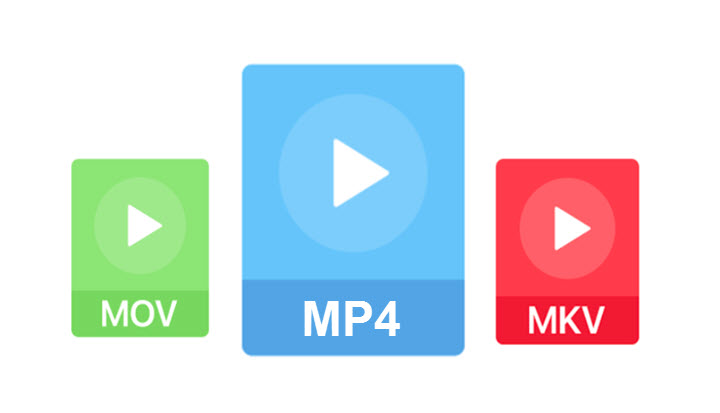
MP4 is a digital multimedia format and was developed under the standard of ISO/IEC and MPEG in 2001 based on the QuickTime format MOV preferred by the Apple devices. The version we are using is MPEG-4 Part 14 (ISO/IEC 14496-14:2003), which, compared to the initial one, is revised to the international standard for audio-visual coding and widely supported by laptops, mobiles, TVs, multimedia software, and websites.
MP4 can store data of all sorts ranging from digital audio and video to subtitles and still images. But note that .mp4 is not the only extension for it. .m4a stands for the audio-only file in MP4 and .m4v for the DRM video in MP4. Generally, MP4 uses MPEG-4 for video compression and AAC for audio compression. With the rapid growth of the coding algorithm, MP4 supports more modern codecs. To make sure whether MP4 is the best format for you, you should check the compatible MP4 codecs.
Supported Video Codecs: MPEG-2, MPEG-4, H.264/AVC, H.265/HEVC, and more.
Supported Audio Codecs: AAC/MPEG-1 Layers I, II, III/AC-3, MP3, etc.
Advantages
- High-degree compression rate to produce smaller video files.
- Natively supported by most devices, players, programs, and online platforms.
- Independent storage for videos and audio files so that you can extract either of them from MP4.
- Fast video transmission over the internet.
Disadvantages
- Lossy compression degrades video quality to some extent.
- Accurate video editing needs more I frames, but MP4 (h.264) videos contain more B/P frames.
2. MOV (QuickTime File Format)

MOV, also known as QuickTime File Format (QTFF), is a proprietary format developed by Apple. Like MP4, MOV holds an array of media like video effects, audio, and texts. MOV has a high compression ratio and high definition. It can save alpha channels and also support 25 bits color and 150 video effects. Moreover, it is equipped with more than 200 stereo and sound devices for MIDI. MOV format was originally created for QuickTime Player on macOS, but now it is also accessible to iOS and Windows.
Apple has designed 2 official file extensions for it: .mov and .qt. However, the latter has phased out and cannot be recognized by web servers these days. Though the sole name presents, MOV videos differ from each other in video codecs. Commonly used codecs include MPEG-4, H.264/AVC, and H.265/HEVC.
Supported Video Codecs: MPEG-2, MPEG-4 Part 2, H.265, H.264, H.263, Apple ProRes, Cinepak, Component Video, DV, DVC Pro 50, Motion JPEG, QuickTime Animation, Sorenson Video 2/3
Supported Audio Codecs: AAC, HE-AAC, Apple Lossless, MP3, AMR Narrowband, MS ADPCM, QDesign Music 2, Qualcomm PureVoice (QCELP), IMA 4:1, MACE 3:1, MACE 6:1, ALaw 2:1, ULaw 2:1
Advantages
- High quality to play and save 1080p, 4K, 8k videos.
- Separate tracks for different data – video, audio, text, effects, and metadata.
- Easier to edit without rewriting the entire file when using Final Cut Pro.
Disadvantages
- Take significant memory on your hard drive.
- Inaccessible on browsers without the QuickTime plugin or devices without MOV-friendly players.
- Require higher computing capability when the MOV video is encoded in H.265.
3. MKV (Matroska)
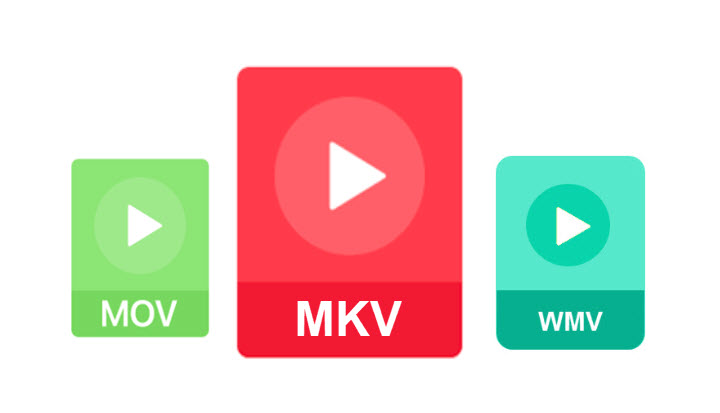
The Matroska multimedia container format was born free and open-source in 2002. The name was derived from the Russian Matryoshka doll that contains numerous smaller, nested dolls of the same shape, which indicates this container can encapsulate multiple encoded images, audio, and subtitles of various formats into one media file.
Besides distinguishing MKV from .mkv extension, there are .mka for audio-only files, .mks for subtitles only, and .mk3d for stereoscopic video. Most TV shows and movies tend to utilize MKV to store multi-track audio files and subtitles (SubRip, WebVTT, ASS, SSA). But due to its sheer complications, it is not widely supported among end devices and video editing software.
Supported Video Codecs: Almost all common codecs.
Supported Audio Codecs: Almost all common codecs.
Advantages
- Highly flexible to support any combination of video and audio codecs.
- More flexible support for menus, chapters, and tags in the file.
- Recover and play corrupted files.
- Free and open-source.
- Hold infinite tracks of video, audio, images, and subtitles.
Disadvantages
- Not accepted by most video editors, iMovie, Final Cut Pro, Premiere Pro, etc.
- Best encoded with FFV1 but not standardized yet.
- Keep high-quality results at the cost of large storage.
4. WMV (Windows Media Video)
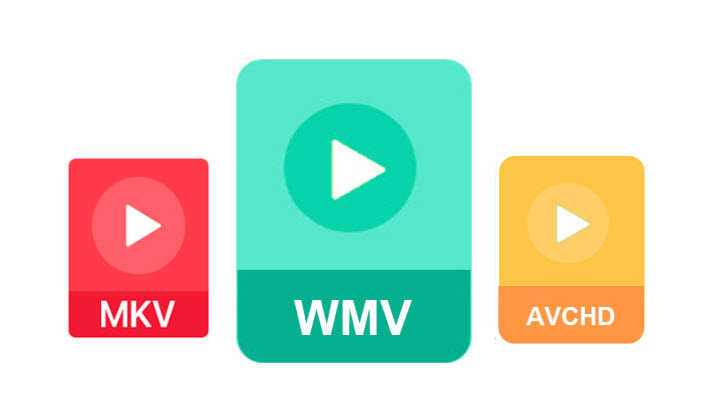
Just like Apple develops its proprietary format, Microsoft released and promoted AVI (Audio Video Interleave) in the early-2000s, but later, AVI lost momentum because of its less compression and bulge size. In the mid-2000s, WMV came to replace AVI. As a part of the Windows Media framework, it has 3 codecs – WMV for video, WMV Screen and WMV Image for specialized content. WMV, the original video compression tech was designed for Internet streaming and regarded as the Microsoft version of RealVideo. To speed up webcasting while maintaining a decent quality, WMV gives up other relevant data of tags, text, and metadata, except video and audio.
Videos with .wmv extension are compressed with Windows Media Video codecs, while .wma is an audio file with Windows Media Audio codecs. Besides, you might see a WMV video with a .asf extension instead of .wmv. This is a video formatted in ASF (Advanced System Format) container but encoded with WMV codecs. Microsoft has upgraded these codecs consistently. The current WMV 9 provides a compression ratio 2x higher than MPEG-4 and 3x than MPEG-2 and gains well adoption to physical file formats like HD DVD and Blu-ray Disc.
Supported Video Codecs: Windows Media Video 9/8/7, VC-1, MPEG-4.
Supported Audio Codecs: Windows Media Audio 9, MP3, Microsoft G.7 series, Microsoft ADPCM.
Advantages
- It compresses large data files in smaller sizes.
- It is an ideal format for streaming, sharing, and storage.
- Runs perfectly on Microsoft-supported operating systems and devices.
Disadvantages
- Not supported by Mac and Linux without the help of a WMV player.
- Users need to install WMV players on Apple ecosystem and Linux system.
- Windows Media DRM prevents people from playing and editing WMV videos freely.
- Inability to select aspect ratio manually.
5. AVCHD (Advanced Video Coding High Definition)
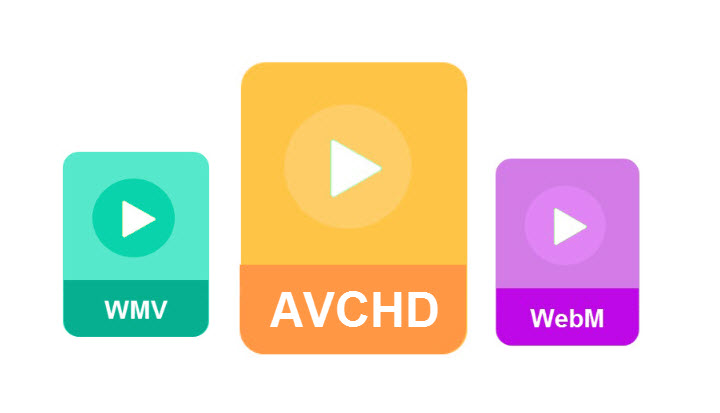
AVCHD is a video format designed jointly by Sony and Panasonic, two giant camcorder manufacturers. Therefore, the format was born for recording high-definition videos. The format takes on its competitors by adding more features, such as menu support, subtitles, and slide shows. It can be stored and played on any storage devices like flash drives or SD cards. This format supports a wide variety of high definition variants. As a result, it has been the go-to standard among pro videographers.
AVCHD video is recorded using the MPEG-4 AVC/H.264 compression codec, the same used with most Blu-ray Disc. Dolby Digital (AC3) audio or uncompressed PCM audio is supported. Multimedia content is multiplexed together as an MPEG-2 Transport Stream. AVCHD typically uses the .mts and .m2ts file extensions.
Supported Video Codecs: MPEG-4 AVC/H.264
Supported Audio Codecs: Dolby Digital (AC3), PCM
Advantages
- High quality support for both video and audio.
- Default video format of Sony and Panasonic gadgets.
- Native support among most Blu-ray players on the market.
Disadvantages
- Not supported by iOS devices.
- Limited to high-end hardware.
6. WebM
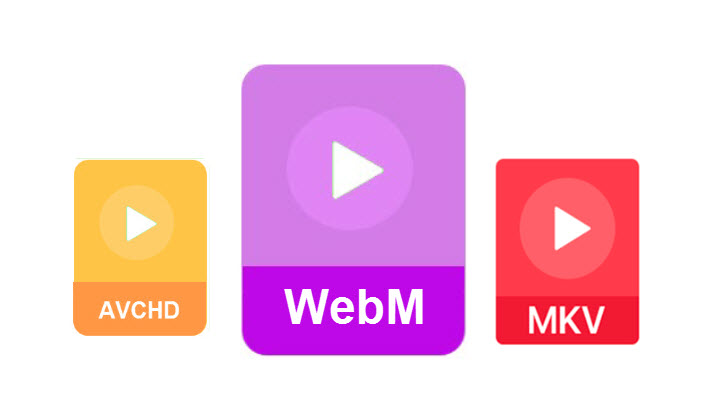
Different from patented formats above, WebM is an open and royalty-free format for the web. This relatively new format is developed with the assist of Google back in 2010. Soon it becomes the main format container for videos you watch on the web, such as HD movies, amateur videos, live streaming, video calling. WebM videos can be embedded into a website by using HTML5 video tag and playback without plugins. Now the majority of modern web browsers support WebM videos, such as Chrome, Firefox, and Apple Safari.
WebM defines the container structure and how the video and audio are encoded. The WebM container is based on a profile of Matroska. It succeeds to mature features of Matroska but missing metadata, attachments, and chapter data. At the very beginning, it compressed video stream with VP8 codec and audio stream with Vorbis. In 2013, VP9 is accommodated, which similar advantages of H.265 in the aspect of quality and size as it can reduce the bit rate of video transmissions by 50% while keeping a sharp quality.
Supported Video Codecs: VP8, VP9
Supported Audio Codecs: Vorbis, Opus
Advantages
- Reduce the size of video assets to a large extent.
- 100% free and anyone can use it without charge.
- Produce higher quality videos and better playback performances.
- Huge future potential for online use.
Disadvantages
- Cannot be played on a broad array of portable devices.
- The encoding speed of WebM (VP9) is a little slow.
7. FLV (Flash Video Format)
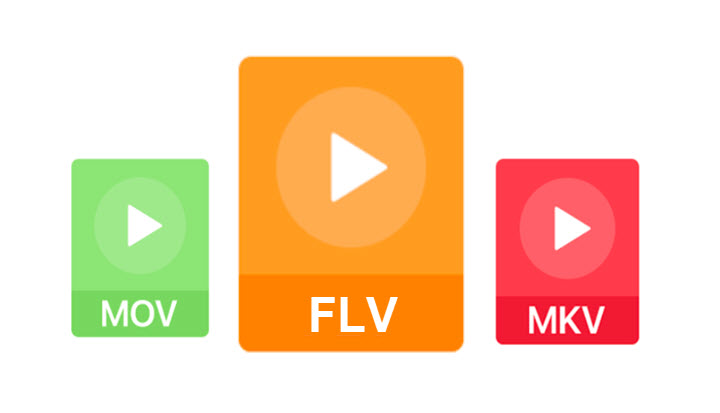
FLV is another video format aiming to deliver high-quality videos using Adobe Flash Player version 6 and newer over the internet in this list. It was developed by Macromedia and comprised of a short header, video, interleaved audio, and meta descriptions. FLV allows higher rates of data compression than MP4 while retaining a good video quality, thus saves much bandwidth. But when the industry shifting to HTML5 royalty-free WebM, FLV format and its accompanying browser plugins get less competitive.
There are two Flash Video file extensions: .flv and .f4v. They are both developed by Adobe and supported by Flash Player but differ in content structures. FLV, an old standard version from Adobe for Flash video, encodes video and audio data in a way that similar to SWF, while F4V files are built on the standard ISO-based format.
Supported Video Codecs: Sorenson Spark, H.264, VP6.
Supported Audio Codecs: MP3, AAC, HE-AAC.
Advantages
- Small file size for fast downloading and sharing.
- Preferred by mainstreaming video platforms, YouTube, Hulu, and Google video.
Disadvantages
- Decline in popularity these days.
- Corresponding playback plugin Adobe Flash Player will be discontinued at the end of 2022.
- Many mobile phones can't open FLV without third-party tools.
How to Pick the Best Video Format for Different Needs
The best video format actually depends on your goals, for sharing, archiving, editing, or playing. Here we break it down into specific scenarios.
1. Best Video Format for Social Media
One of the purposes we make videos is to share them with the public. You can spend every effort to shoot and polish your videos, but all of these are in vain if you don't post them in the right format. All social media platforms seem to support the golden format, MP4, but there are differences when it comes to codecs and more elements.
Best Video Format for YouTube
- Video Container: MP4 (recommended), MOV, AVI, WMV, FLV, WebM
- Video Codec: H.264 (recommended), VP9, HEVC, DNxHR, ProRes, CineForm
- Frame Rate: 24 - 60fps
- Bit-rate: 30Mbps for 4K videos, 8Mbps for 1080P, 5Mbps for 720P
- Resolution: 360P to 4K (2160P)
Further Reading: How to Upload 4K Video to YouTube in the Best Format
Reference: https://support.google.com/youtube/troubleshooter/2888402?hl=en
Best Video Format for Facebook
- Video Container: MP4, MOV, and 30+ compatible but not preferred formats
- Video Codec: H.264. If not, Facebook will transcode your video to H.264
- Frame Rate: 25 -30 fps
- Bit-rate: Maximum 4 Mbps
- Resolution: 720P, 480P, 360P
Reference: https://www.facebook.com/help/218673814818907?helpref=uf_permalink
Best Video Format for Instagram
- Video Container: MP4 (recommended), MOV
- Video Codec: H.264
- Frame Rate: 30 fps or fewer
- Bit-rate: 3500 kbps bitrate
- Resolution: Maximum 1080P.
Further Reading: How to Upload High Quality Videos to Instagram
Best Video Format for Twitter
- Video Container: MP4 and MOV for its mobile app; MP4 for its web version
- Video Codec: H.264
- Frame Rate: 40 fps or fewer
- Bit-rate: Up to 25 Mbps
- Resolution: Maximum 1920 x 1200
Further Reading: How to Upload Video to Twitter - Can't Upload Error Fixed
Reference: https://help.twitter.com/en/using-twitter/twitter-videos
2. Best Video Format for Archiving Home Movies
When it comes to archiving your precious home movies, there are 2 main factors you should take into account:
Formats compression ratio. It decides how much space the videos occupy and how the image quality is. H.264 and H.265 are the most recommended coding schemes that keep a reasonable compression ratio while degrading less quality. Newcomers AV1 allows higher compression ratio but is less popular among home theater players nowadays.
Compatibility. It means whether these videos are stored in a format that is widely accepted by both current and future players, TVs, projectors, PCs, etc. AVI and FLV format containers were used frequently in the past, but it due to its unpredictable future, we would suggest classic formats like MP4, MKV, MOV, among which MKV contains more video, audio, subtitles tracks.
In a nutshell, MP4, MOV, and MKV video file container with H264/MPEG-4 AVC and H265/HEVC video codecs are suitable for archiving digital home movie. You can apply any of the three codecs to MP4, MOV, and MKV format containers in your favor.
3. Best Video Format for Web
Frankly speaking, there is no one-fit-all format due to the restriction in the compatibility of video formats and different requirements in quality and compression ratio. So after an overall consideration of these factors, we sum up 2 formats for videos in HTML5.
VP9 WebM
VP9 has similar advantages of H.265 in the aspect of quality and size as it can reduce the bit rate of video transmissions by 50% while keeping a sharp quality. Suppose your bandwidth only allows you stream videos in 360P previously, VP9 now enables you to playback 720p videos effortlessly. The encoding speed is a little slow but better than H.265 and the decoding efficiency is lower than that.
Note: VP9 only goes compatible with Google. Apple users still need to turn to H.264 or H.265 for help. But suppose you have many Android users, VP9 still deserves a try.
H.264 (AVC) MP4
H.264 is a workable web video compress format in associate with a MP4 container. In terms of quality and compression rate, it relies mainly on temporal compression and motion prediction to shrink the size. The compression ratio and output quality depend on the profile setting with H.264 including baseline, main and high profile, among which, the high profile setting is most recommended as it compresses video at a ratio of 2000:1 with less sacrifice in quality.
4. Best Video Format for PowerPoint (All Versions Included)
Generally speaking, most video formats are compatible with PowerPoint 2013, 2016, and 2019. If you are using PowerPoint 2010 or 2007, videos contained in .mp4 format are not allowed to be played in it. The most recommended formats are AVI, WMV, ASF, and MPG.
5. Best Video Format for Smart TV
A so-called best format here refers to the format which is widely accepted by the main-stream 4K smart TVs on the market and can provide high-quality video display under a 4K condition. Of course, it would be a bonus if the video in such format takes up less storage space. Listed below are the most popular 4K TVs sold in the market and a comparison between their supported video formats.
Apple TV supported video formats
- Container: M4V, MP4, MOV
- Video Codec: H.264, HEVC, MPEG-4, Motion JPEG
Samsung TV supported video formats
- Container: AVI, MKV, ASD, MP4, MOV, FLV, VRO, TS, SVAF
- Video Codec: Divx 3.11/4/5/6, MPEG SP/ASP, Motion JPEG, H.260 BP/MP/HP, Microsoft MPEG 4v3, Windows Media Video v7. v8. v9, MPEG 2, MPEG 1, VP6, MVC, VP8, H.264
Sony 4K TV supported video formats
- Container: MP4, AVI, WMV, MOV, MKV, 3GPP
- Video Codec: MPEG, MPEG2, AVC, MPEG4, HEVC, Motion JPEG
Panasonic 4K TV supported video formats
- Container: MP4, AVI, WMV, M4V, MKV, 3GPP
- Video Codec: HEVC, FLV, VRO, VOB, TS, PS
More Formats You Might Be Interested in:
1. Best Video Format for Plex: MKV, MP4, or Something Else?
2. Best Video Format for iPhone: Convert, Edit and Process iPhone 4K/HD Videos








